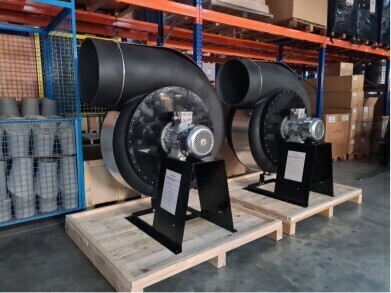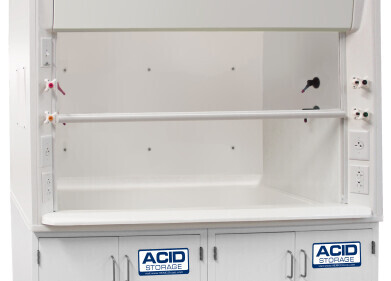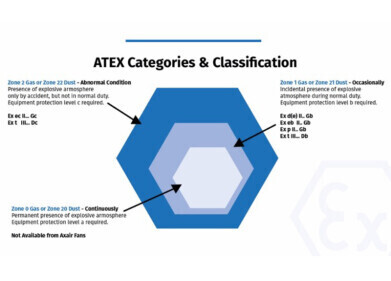Fume Extractors
Carbon Loading Polypropylene Fume Fans to Prevent Electrostatic Discharge in ATEX Environments
Feb 21 2024
To avoid electrostatic discharge, plastics used in explosive fume extraction systems that move air, or are situated in an area where potentially hazardous fume are present, must be electrically conductive or static dissipative. The most effective way of dissipating electrostatic discharge is to add conductive carbon black to the polymer matrix.
For the context of this article, we’ll consider how polypropylene corrosion resistant fans which are the preferred construction material used to handle toxic and hazardous fumes in fume extraction systems, are modified to enhance the ATEX suitability for zone 2 potentially explosive environments. These ATEX certified polypropylene fans are manufactured from polymers that have special branched carbons with a structure that can transport the flow of electrons and dissipate electrostatic charge.
In potentially explosive environments, if the conditions call for it, such as the build-up of IIC hydrogen gas in large quantities, the presence of static discharge can be enough to ignite and cause an explosion. The concept of ensuring a product is ATEX certified ensures that the fan component in our case, is not itself, a risk or an ignition source. ATEX fans reduce the risks of creating sparks from friction, static electricity or from arcs in motor malfunctions for example. In ATEX product labelling, Ex h markings signify that the non-electrical fan component (excluding the motor) has been constructed sufficiently to be used as intended in an explosive environment. In short, precautions during the manufacturing process have reduced this risk.
The Nature of Polymers
By nature, without additives or fillers, commercial plastics, such as polypropylene, are electrical insulators. Charges deposited on the polymer surface are living therefore a long time, and the longer the lifetime, the more likely the possibility of an electrostatic discharge event such as static discharge. The rate of charge dissipation is known as the charge decay time, this considers the electric resistivity which tells us how strongly a material opposes the flow of electric current, and the dielectric permittivity, which characterises the ability of the material of storing an electrical charge when subjected to an applied voltage.
For static dissipation, we must reduce the decay time of the charge, by enhancing conductivity and reducing permittivity. The loading of polymers with conducting additives reduces the resistivity of polymers. Let’s briefly look at what we use in our ATEX polypropylene fans to increase conductivity and reduce static electricity.
Enhancing Conductivity with Carbon Fillers
Due to the presence of static charges, polymers must be turned into materials able of draining these charges and protect the devices from static discharges. Therefore, the polymers must be capable of conducting electricity to some extent. As previously mentioned, commercial polymers are natural electrical insulators, so they need to be engineered to become anti-static dissipative or conductive. This is realised either through chemical treatment or through the addition of conductive agents during the processing.
One of those fillers is known as carbon black, a relatively inexpensive and processible filler material, formed by burning hydrocarbons in a limited oxygen environment. These are used extensively in packaging but also used, as shown in our ATEX corrosion resistant range, for CB filled high density and low-density polypropylene.
Simply put, carbon loading is a process in which carbon black particles or fibres are incorporated into the polypropylene during manufacturing. This addition of carbon enhances the conductivity allowing it to dissipate accumulated static charge more effectively, minimising the risk of ESD. Where airflow passes through fan blades, friction can generate static charges on the fan surfaces, and in environments with combustible materials, static charges can ignite or trigger an explosion
So, in a nutshell, that’s how we ensure that our ATEX polypropylene fans are manufactured in line with the ATEX directive, making them suitable for their intended use. Explore the polypropylene range here.
Digital Edition
International Labmate 49.6 - Sept 2024
September 2024
Chromatography Articles - HPLC gradient validation using non-invasive flowmeters Mass Spectrometry & Spectroscopy Articles - From R&D to QC, making NMR accessible for everyone: Putting NMR...
View all digital editions
Events
Oct 30 2024 Birmingham, UK
Oct 30 2024 Manchester, UK
Nov 11 2024 Dusseldorf, Germany
Nov 12 2024 Cologne, Germany
Nov 12 2024 Tel Aviv, Israel



















